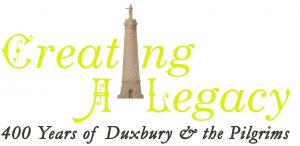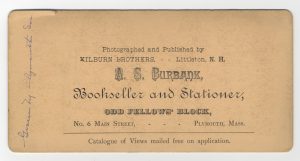Black and white postcard of the Alexander Standish House
 Black and white postcard of the Alexander Standish House, circa 1930
Black and white postcard of the Alexander Standish House, circa 1930
E. D. West Co
Ink on paper
Gift of the Duxbury Free Public Library, DAL.2019.057.29
Postcard of the “Alexander Standish house” to be sold in Paul Peterson’s drug store known as The Duxbury Pharmacy.
This house was purported for years to have been built by Alexander Standish (1626–1702), son of Myles Standish, in 1666. For souvenirs, it was primarily marketed, however, as the Myles Standish House or simply the Standish House. The land it sits on, at 341 Standish Street, is part of the original land grant that was owned by Myles Standish, but architectural elements suggest that it is closer to a mid-18th century house. A Boston entrepreneur, Stephen Allen, purchased the property in 1870 and envisioned an elaborate summer resort community to go along with the building of the Myles Standish Monument. He was assumed to be the one that painted “1666” on the chimney and claimed the home had been built by a Standish.
Paul Chester Peterson (1883-1950) was born and raised in Duxbury. He became a clerk at the pharmacy of Nathan Stetson, eventually buying the firm, in 1907. As a pharmacist, Paul C. Peterson was an entrepreneur, he initiated a mail delivery for his customers, sold post cards and maps of Duxbury, and imported souvenir pottery.
Related Object: Stereoview of the Standish House, circa 1900, A.S. Burbank, Plymouth, Silver gelatin print on board, Gift of the Plymouth Antiquarian Society.
Stereoviews, or stereoscopic images, were almost identical photographs, set side by side. When viewed through a stereoscope, the image appeared three-dimensional. They became a common souvenir item, like post cards, depicting popular scenes and locations.
Digging Duxbury
The quest for archaeological evidence of the Pilgrim past began with an 1833 dig, one of the earliest in U.S. history.
Coming to a Pilgrim Town
Coming to a Pilgrim Town
Duxbury’s Pilgrim history, combined with the town’s natural beauty, initiated a tourist boom.
Collecting in a Pilgrim Town
Collecting in a Pilgrim Town
The tourism boom brought another enterprise, the creation and sale of Pilgrim-themed souvenirs.
Lasting Legacy
Duxbury's Lasting Legacy
Duxbury never forgot its Pilgrim origins. How could it? The names continue to generate interest today.
Return to Exhibition Main Page.



